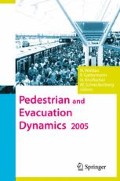Abstract
Evacuation analysis of passenger and commercial shipping can be undertaken using computer-based simulation tools such as maritimeEXODUS. These tools emulate human shipboard behaviour during emergency scenarios; however it is largely based around the behaviour of civilian passengers and fixtures and fittings of merchant vessels. If these tools and procedures are to be applied to naval vessels there is a clear requirement to understand the behaviour of well-trained naval personnel interacting with the fixtures and fittings that are exclusive to warships.
Human factor trials using Royal Navy training facilities were recently undertaken to collect data to improve our understanding of the performance of naval personnel in warship environments. The trials were designed and conducted by staff from the Fire Safety Engineering Group (FSEG) of the University of Greenwich on behalf of the Sea Technology Group (STG), Defence Procurement Agency. The trials involved a selection of RN volunteers with sea-going experience in warships, operating and traversing structural components under different angles of heel. This paper describes the trials and some of the collected data.
Access this chapter
Tax calculation will be finalised at checkout
Purchases are for personal use only
Preview
Unable to display preview. Download preview PDF.
References
E.R. Galea, L. Filippidis, S. Gwynne, P. Lawrence, G. Sharp, D. Blackshields: The Development of an Advanced Ship Evacuation Simulation Software Product and Associated Large Scale Testing Facility for the Collection of Human Shipboard Behaviour Data, In: Proceedings International Conference on Human Factors in Ship Design and Operation, The Royal Institution of Naval Architects, London, pp. 37–50 (2002).
E.R. Galea, P. Lawrence, S. Gwynne, G. Sharp, N. Hurst, Z. Wang, and J. Ewer: Integrated Fire and Evacuation in Maritime Environments, In: Proceedings of the 2nd International Maritime Safety Conference on Design for Safety, Sakai Japan, Publisher Ship and Ocean Foundation, 27—30 Oct 2004, pp. 161–170 (2004).
IMO MSC Circular 1033, June 2002 (2002).
RN Escape and Evacuation Data Collection Trials, Quintec Associates Limited QAL/P1167/02/2.5/04/02-7
P.J. Lawrence, S. Gwynne, E.R. Galea, and G. Sharp: NADMAP 320: Extending The Capabilites Of The maritimeEXODUS Ship Evacuation Model To Include Ladders, Hatches And 60 Degree Stairs, Report prepared for the MoD Sea Technology Group, November 2002 (2002).
E.R. Galea, S. Gwynne, D. Blackshields, P. Lawrence, L. Filippidis: Predicting the Evacuation Performance of Passenger Ships Using Computer Simulation, In: Proceedings of the 9th International Fire Science Conference Interflam 2001, Interscience communications, ISBN 0953231275, Edinburgh, pp. 853–864 (2001).
D.A. Purser: Toxicity Assessment of Combustion Products, In: P.J. Dilenno, C.L. Beyer, R.L.P. Custer, W.D. Walton, J.M.W. Watts, D. Drusdale, J.R. Hall (Eds.), The SFPE Handbook of Fire Protection Engineering (2nd Edition), National Fire Protection Association, Quincy, Ma, pp. 2-85–2-146 (1996).
S. Gwynne: The Introduction of Adaptive Social Decision-Making in the Mathematical Modelling of Egress Behaviour, PhD. Thesis, University of Greenwich, London (2000).
T. Jin: Visibility Through Fire Smoke, Journal of Fire and Flammability, 9, pp. 135–155 (1978).
BMT Fleetechnology, Ottawa Canada, 2002, http://www.shebafacility.com
W. Bles, S. Nooy, and L.C. Boer: Influence of Ship Listing and Ship Motion on Walking Speed, In: M. Schreckenberg and S.D. Sharma (Eds.), Proceedings of the International Conference on Pedestrian and Evacuation Dynamics, Springer, Berlin, ISBN 3-540-42690-6, pp. 437–452 (2002).
F. Caldeira-Saraiva, J. Gyngell, R. Wheeler, E.R. Galea, A. Carran, R. Skjong, E. Vanem, K. Johansson, B. Rutherford, and A.J. Simoes: Simulation of Ship Evacuation and Passenger Circulation Re, In: Proceedings of the 2nd International Maritime Safety Conference on Design for Safety, Sakai Japan, Publisher Ship and Ocean Foundation, 27–30 Oct 2004, pp. 197–205 (2004).
E.R. Galea and J. Gyngell: The European Union Fire-Exit Project, Improving Maritime Safety, Cruise Ship Interiors International, Summer 2004, pp. 60–65 (2004).
Author information
Authors and Affiliations
Editor information
Editors and Affiliations
Rights and permissions
Copyright information
© 2007 Springer-Verlag Berlin Heidelberg
About this paper
Cite this paper
Gwynne, S., Filippidis, L., Galea, E.R., Cooney, D., Boxall, P. (2007). Data Collection in Support of the Modelling of Naval Vessels. In: Waldau, N., Gattermann, P., Knoflacher, H., Schreckenberg, M. (eds) Pedestrian and Evacuation Dynamics 2005. Springer, Berlin, Heidelberg. https://doi.org/10.1007/978-3-540-47064-9_42
Download citation
DOI: https://doi.org/10.1007/978-3-540-47064-9_42
Publisher Name: Springer, Berlin, Heidelberg
Print ISBN: 978-3-540-47062-5
Online ISBN: 978-3-540-47064-9
eBook Packages: Mathematics and StatisticsMathematics and Statistics (R0)

